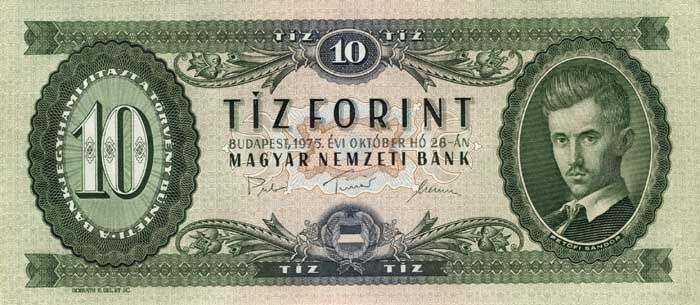On 4 August 1946, a radio station in Budapest reported on the stabilisation of Hungary's monetary system and the strengthening of the new national currency, the forint. In 1946, the Magyar Nemzeti Bank (Hungarian National Bank) introduced 10 and 100 forint banknotes. A new series of higher denomination banknotes (10, 20, and 100 forints) was introduced between 1947 and 1948. The 50 forint banknote was printed in 1953.
The forint and the filler were introduced into circulation on 1 August 1946 following the de facto abolition of the previous currency, the pengö, caused by unprecedented global hyperinflation. The forint replaced the pengö at the rate of one forint to 400 million pengö (by that time the phenomenal rate of inflation in post-war Hungary was over 400 percent a day – prices soared fivefold every day, pengö notes became worthless in an instant and new ones had to be introduced – 10 million, 100 million, and, finally, 1 billion).
The new title referred to the Hungarian name for the currency of Austria-Hungary, also known as the Austro-Hungarian gulden or Austrian florin.
The introduction of the new currency was backed by government support measures. From this point on, the government set maximum prices for food products and grocery shops were kept open on weekends. Farmers were ordered to accept the new currency for their goods. In 1946, there was virtually no industry in Hungary because of the post-war devastation. The return of Hungary's gold reserves from Frankfurt, where they had been taken during the war and kept under the control of the Nazi government (the reserves amounted to approximately $32 million), played a significant role in stabilising the forint.
The Hungarian forint remained a stable currency for about 25 years. During the 1970s and 1980s, Hungary's socialist economy lost its competitiveness and, following the country's democratisation in 1989-90, lost up to 35 percent of its purchasing power over three years. In 1990, the filler was withdrawn from circulation due to inflation. Relative stabilisation of the forint was achieved in the 2000s.
Source:
The newspaper “Pravda”, No. 185 (10267) from 5 August 1946
























